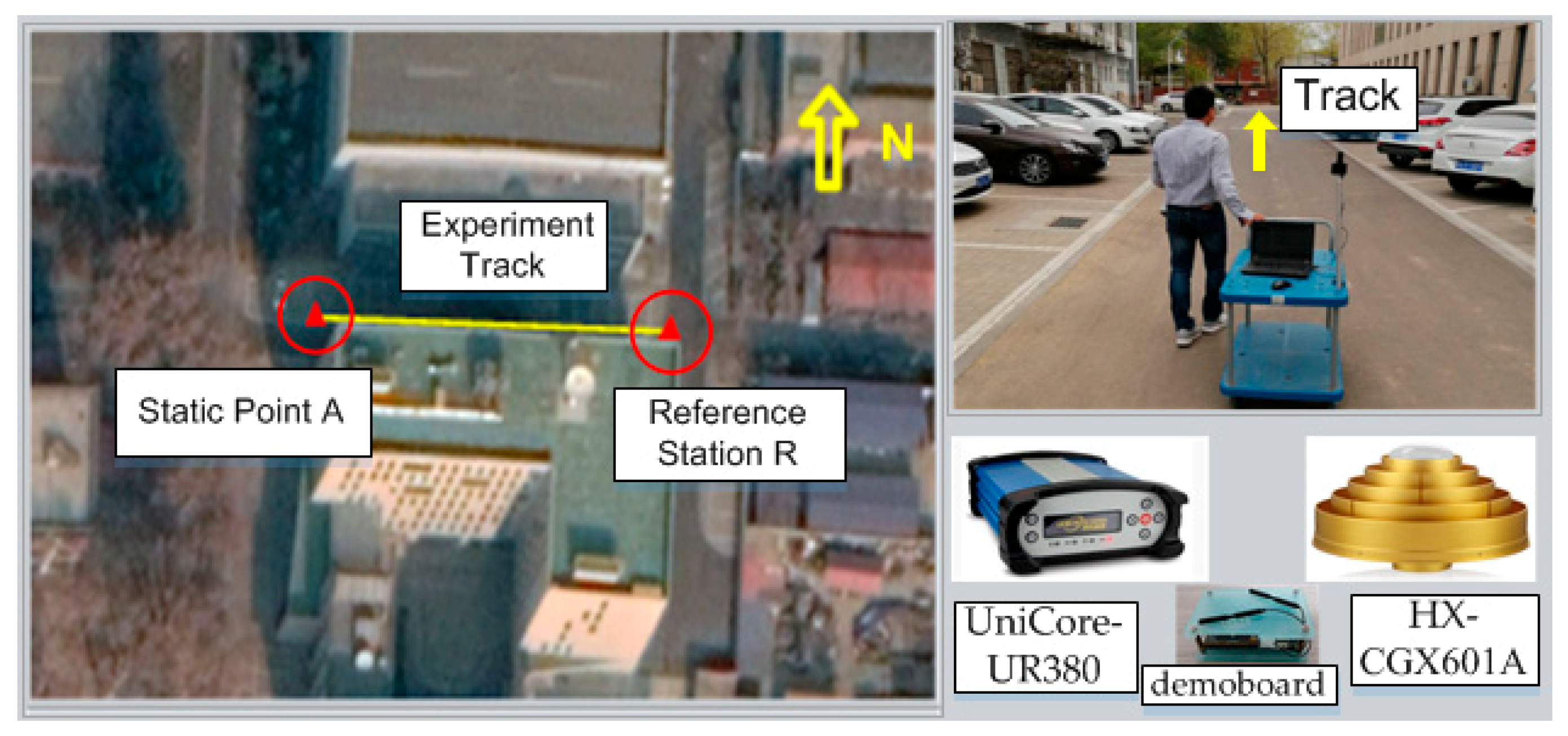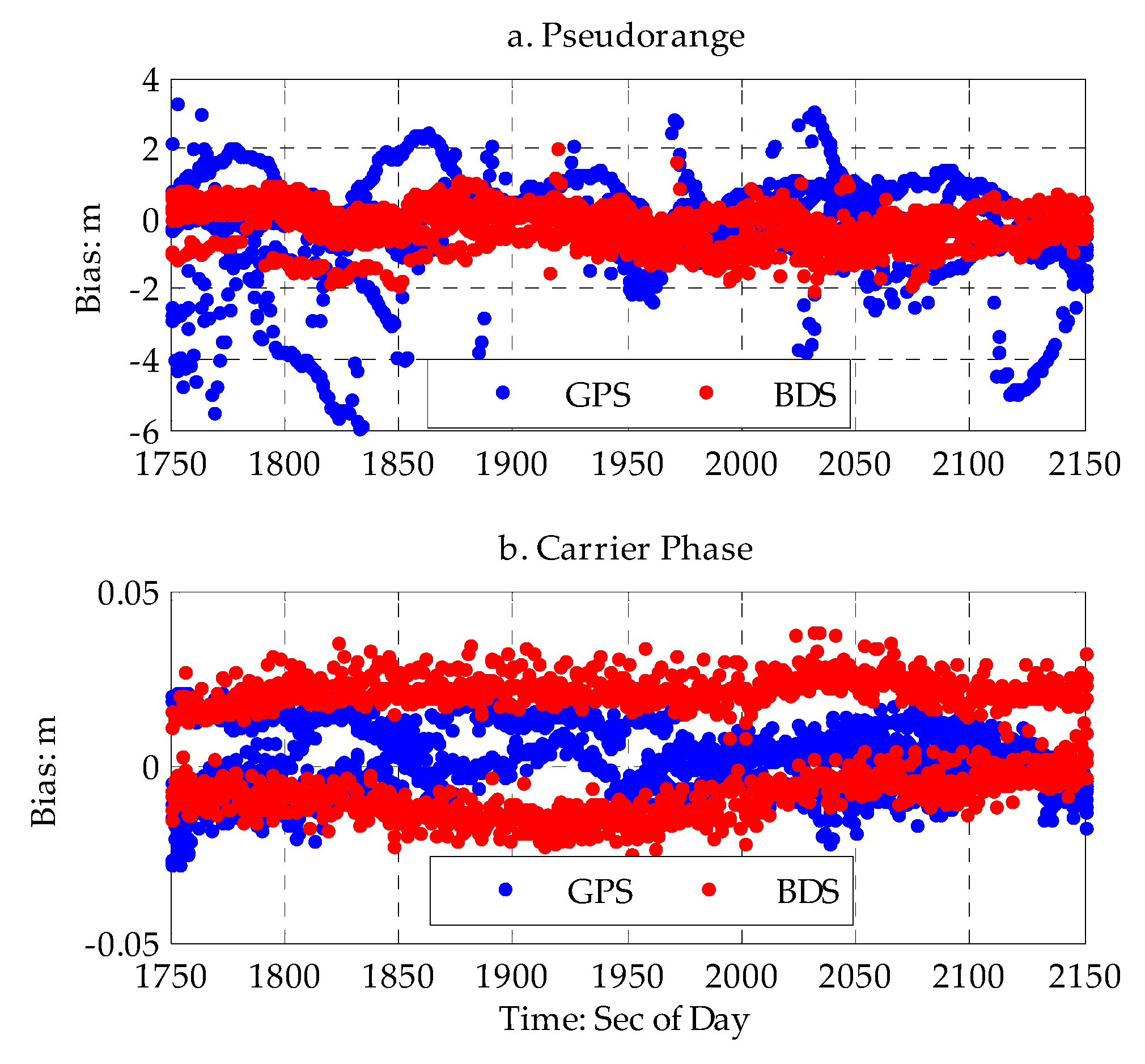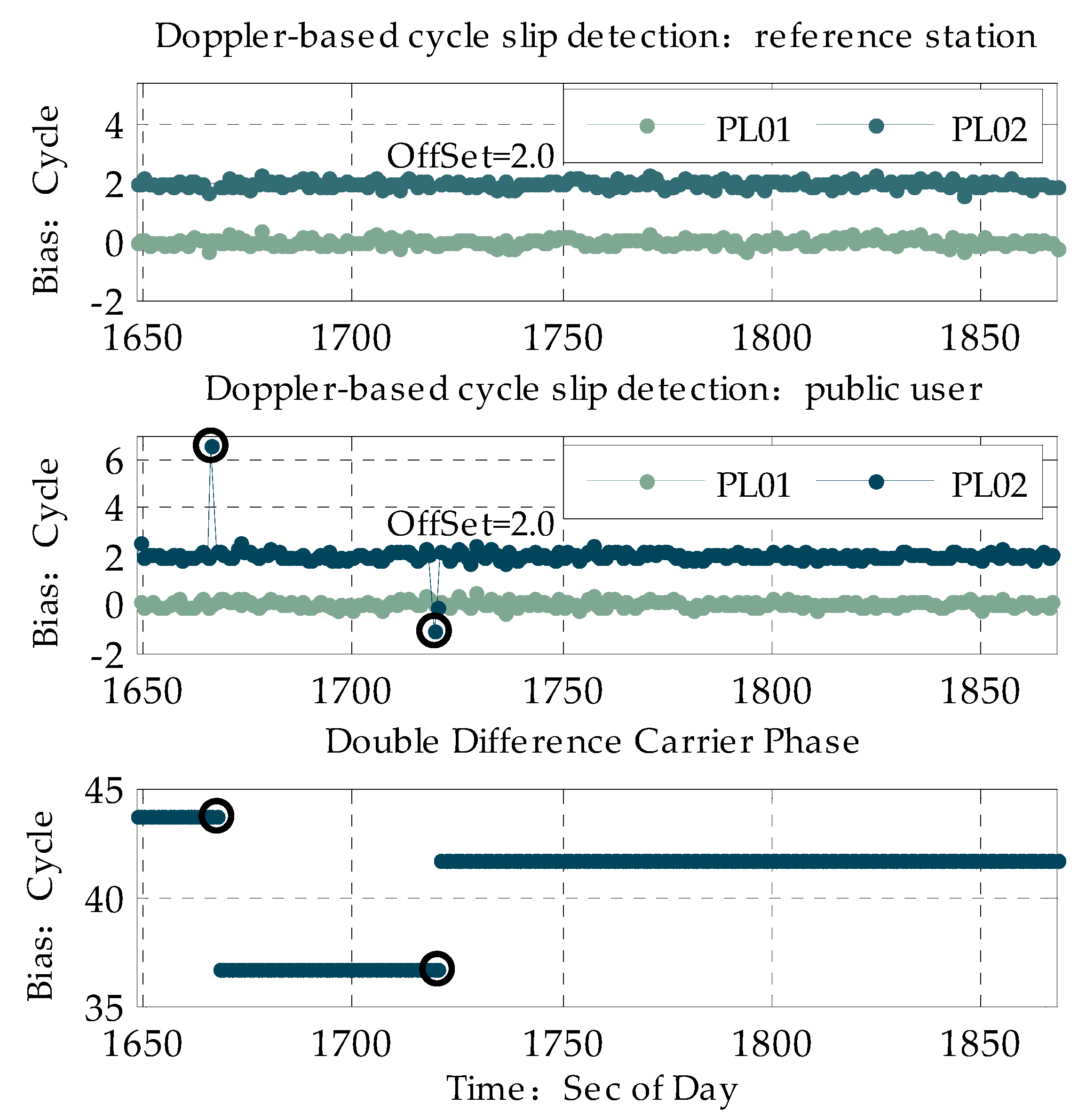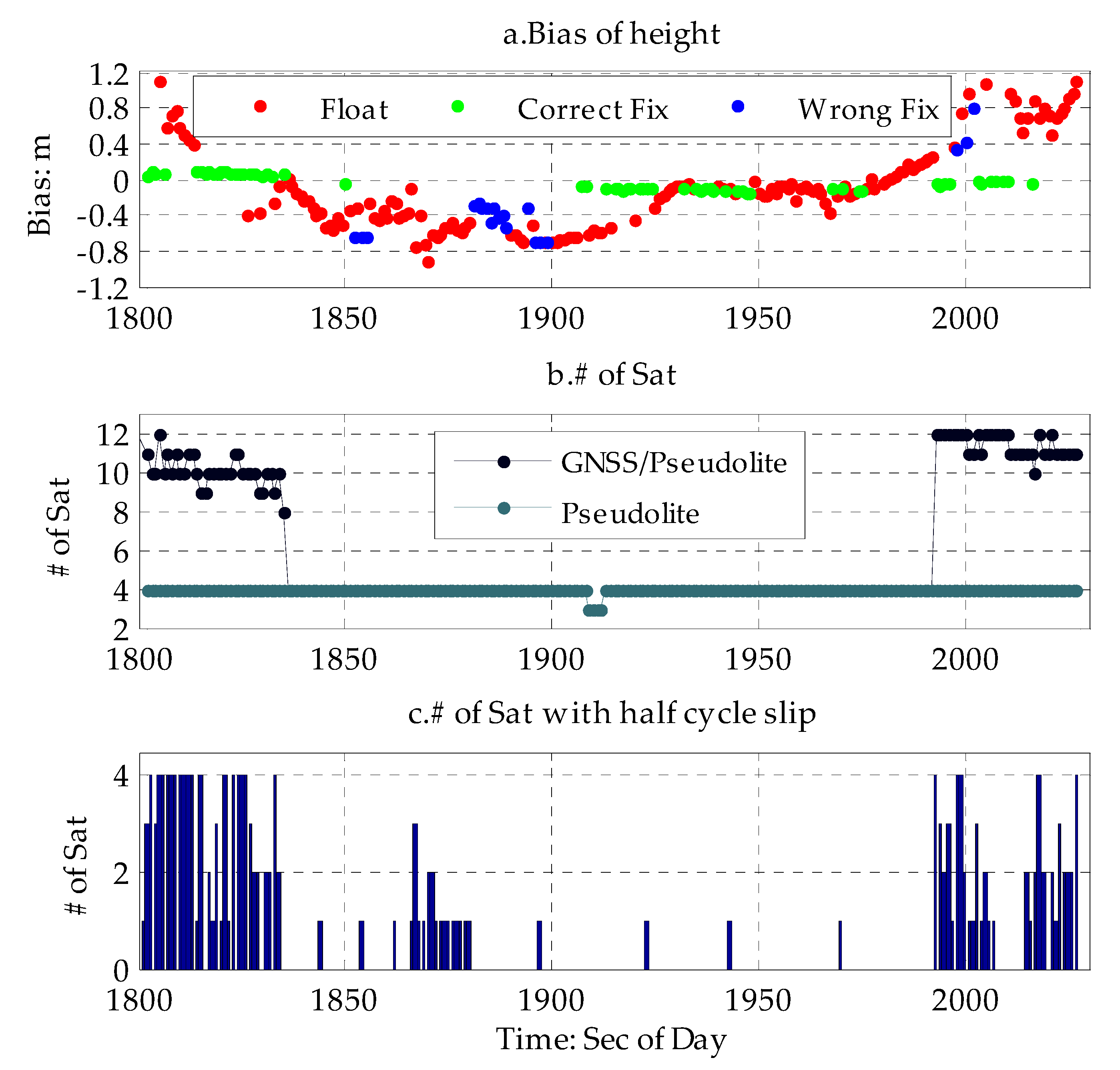Precise Point Positioning Algorithm for Pseudolite Combined with GNSS in a Constrained Observation Environment
Abstract
1. Introduction
2. Methodology
2.1. GNSS/Pseudolite Measurement Model
2.2. GNSS/Pseudolite Time Synchronization Method
2.3. GNSS/Pseudolite PPP Observation Equation
2.4. Integer Ambiguity Resolution and Validation
3. Implementations and Evaluation
3.1. Pseudolite Measurement Error Analysis
3.2. GNSS Measurement Error Analysis
3.3. Doppler-Based Cycle Slip Detection
3.4. GNSS/Pseudolite PPP and Results
4. Conclusions
Author Contributions
Acknowledgments
Conflicts of Interest
References
- INPT. Sébastien Carcanague Low-cost GPS/GLONASS Precise Positioning Algorithm in Constrained Environment. In Signal and Image Processing; Institute National Polytechnique de Toulouse—INPT: Toulouse, France, 2013. [Google Scholar]
- Angrisano, A.; Gaglione, S.; Gioia, C. Performance assessment of gps/glonass single point positioning in an urban environment. Acta Geod. Et Geophys. Hung. 2013, 482, 1–13. [Google Scholar] [CrossRef]
- Vigneau, W.; Carcanague, S.; Julien, O.; Macabiau, C. Low-cost, single-frequency gps/glonass rtk for road users. In Proceedings of the Ion Pacific PNT Meeting, Honolulu, HI, USA, 23–25 April 2013; pp. 168–184. [Google Scholar]
- Jiang, W.; Li, Y.; Rizos, C. On-the-fly Locata/inertial navigation system integration for precise maritime application. Meas. Sci. Technol. 2013, 2410, 105104. [Google Scholar] [CrossRef]
- Jiang, W.; Li, Y. Chris RizosLocata-based precise point positioning for kinematic maritime Applications. GPS Solut. 2015, 191, 117–128. [Google Scholar] [CrossRef]
- Barnes, J.; Rizos, C.; Lee, H.-K.; Roberts, G.W.; Meng, X.; Cosser, E.; Dodson, A.H. The Integration of GPS and Pseudo-satellite for Bridge Monitoring. Window Future Geod. 2005, 1283, 83–88. [Google Scholar]
- Kohtake, N.; Morimoto, S.; Kogure, S.; Manandhar, D. Indoor and Outdoor Seamless Positioning using Indoor Messaging System and GPS. In Proceedings of the International Conference on Indoor Positioning and Indoor Navigation (IPIN2011), Guimarães, Portugal, 21–23 September 2011. [Google Scholar]
- Sakamoto, Y.; Niwa, H.; Ebinuma, T.; Fujii, K.; Sugano, S. Multiplexing Receivers to Improve Positioning Success Rate for Pseudolite Indoor Localization. GPS Solut. 2010, 111, 21–35. [Google Scholar]
- Robert, O.; Teunissen, P.J.G. An assessment of smartphone and with Proximate Multi-channel Pseudo-satellite for Indoor Localization. In Proceedings of the IGNSS Symposium 2013, Gold Coast, Australia, 16–18 July 2013. [Google Scholar]
- Fujii, K.; Sakamoto, Y.; Wang, W.; Arie, H.; Schmitz, A.; Sugano, S. Hyperbolic Positioning with Antenna Arrays and Multi-Channel Pseudolite for Indoor Localization. Sensors 2015, 1510, 25157–25175. [Google Scholar] [CrossRef] [PubMed]
- Powers, E.; Colina, A. Wide area wireless network synchronization using Locata. In Proceedings of the 47th Annual Precise Time and Time Interval Systems and Applications Meeting, Monterey, CA, USA, 25–28 January 2016; pp. 90–98. [Google Scholar]
- Hwang, S.; Yu, D. Clock synchronization of pseudo-satellite using time transfer technique based on GPS code measurement. Int. J. Secur. Appl. 2014, 82, 36–39. [Google Scholar]
- Kim, C.; So, H.; Lee, T.; Kee, C. A pseudolite-based positioning system for legacy gnss receivers. Sensors 2014, 144, 6104–6123. [Google Scholar] [CrossRef] [PubMed]
- Geng, J.; Teferle, F.N.; Meng, X.; Dodson, A.H. Towards PPP-RTK: Ambiguity resolution in real-time precise point positioning. Adv. Space Res. 2010, 4710, 1664–1673. [Google Scholar] [CrossRef]
- Geng, J.; Bock, Y. Triple-frequency GPS precise point positioning with rapid ambiguity resolution. J. Geod. 2013, 875, 449–460. [Google Scholar] [CrossRef]
- Ge, M.; Dousa, J.; Li, X.; Ramatschi, M.; Wickert, J. A novel real time precise positioning service system: Global precise point positioning with regional augmentation. J. Glob. Position Syst. 2012, 111, 2–10. [Google Scholar] [CrossRef]
- Teunissen, P.J.G.; Khodabandeh, A. Review and principles of PPP–RTK methods. J. Geod. 2014, 893, 217–240. [Google Scholar] [CrossRef]
- IPNT-J Seminar. Takasu GNSS Precise Positioning with RTKLIB Part 2; IPNT-J Seminar: Tokyo, Japan, 26 April 2011. [Google Scholar]
- Gan, X.L.; Sheng, C.Z.; Zhang, H.; Huang, L. Combination of Asynchronous Array Pseudolites and GNSS for Outdoor Localization. IEEE Access 2019, 7, 38550–38557. [Google Scholar] [CrossRef]
- Gan, X.L.; Yu, B.G. A New Array Pseudolites Technology for High Precision Indoor Positioning. IEEE Access 2019, 7, 153269–153277. [Google Scholar] [CrossRef]
- Gan, X.L.; Yu, B.G. Doppler differential positioning technology using BDS/GPS indoor array pseudolite system. Sensors 2019, 1920, 4580. [Google Scholar] [CrossRef] [PubMed]
- Potere, D. Horizontal Positional Accuracy of Google Earth’s High-Resolution Imagery Archive. Sensors 2008, 8, 7973–7981. [Google Scholar] [CrossRef] [PubMed]
- Amiri-Simkooei, A.R.; Tiberius, C.C.J.M. Assessing receiver noise using GPS short Time Series. GPS Solut. 2007, 111, 21–35. [Google Scholar] [CrossRef]
- Zhao, S.; Cui, X.; Guan, F.; Lu, M. A Kalman filter-based short baseline RTK algorithm for single-frequency combination of GPS and BDS. Sensors 2014, 148, 415–433. [Google Scholar] [CrossRef] [PubMed]
- Zhang, B.C.; Teunissen, P.J.G.; Yuan, Y.; Zhang, H.; Li, M. Joint estimation of vertical total electron content (VTEC) and satellite differential code biases (SDCBs) using low-cost receivers. J. Geod. 2018, 924, 401–413. [Google Scholar] [CrossRef]
- Selmi, I.; Samama, N.; Vervisch-Picois, A. A new approach for decimeter-accurate GNSS indoor positioning using carrier phase measurements. In Proceedings of the 2013 International Conference on Indoor Positioning and Indoor Navigation, Montbeliard-Belfort, France, 28–31 October 2013. [Google Scholar]
- Shi, J.; Gao, Y. A comparison of three PPP integer ambiguity resolution methods. GPS Solut. 2014, 184, 519–528. [Google Scholar] [CrossRef]







| X | Y | Z | |
|---|---|---|---|
| Transmitting antenna_1 | −2080508.57 | 4578806.61 | 3909545.01 |
| Transmitting antenna_2 | −2080541.75 | 4578790.29 | 3909545.82 |
| Transmitting antenna_3 | −2080510.52 | 4578811.77 | 3909538.01 |
| Transmitting antenna_4 | −2080541.21 | 4578805.15 | 3909545.16 |
| Satellite Pair | Pseudorange (meters) | Carrier Phase (cycle) | ||||||
|---|---|---|---|---|---|---|---|---|
| Max | Min | AVG | RMS | Max | Min | AVG | RMS | |
| PL04-PL01 | 0.677 | −0.699 | 0.008 | 0.195 | 0.012 | −0.012 | 0.000 | 0.003 |
| PL03-PL01 | 0.724 | −0.605 | 0.060 | 0.183 | 0.013 | −0.013 | 0.000 | 0.004 |
| PL02-PL01 | 0.580 | −0.698 | −0.040 | 0.197 | 0.002 | −0.033 | −0.017 | 0.018 |
| Mean | 0.660 | −0.667 | 0.009 | 0.192 | 0.009 | −0.019 | −0.006 | 0.008 |
| Satellite Pair | Pseudorange (meters) | Carrier Phase (cycle) | ||||||
|---|---|---|---|---|---|---|---|---|
| Max | Min | AVG | RMS | Max | Min | AVG | RMS | |
| PL04-PL01 | 7.560 | 3.050 | 5.074 | 5.131 | 0.117 | −0.143 | 0.080 | 0.080 |
| PL03-PL01 | −0.129 | −3.642 | −1.849 | 1.955 | 0.132 | −0.227 | 0.090 | 0.093 |
| PL02-PL01 | −1.985 | −4.552 | −3.292 | 3.331 | 0.165 | −0.198 | 0.099 | 0.102 |
| Mean | 1.815 | −1.715 | −0.022 | 3.472 | 0.138 | −0.189 | 0.090 | 0.092 |
| . | Pseudorange (m) | Carrier Phase (m) | ||
|---|---|---|---|---|
| Average (AVG) | Root-Mean-Square (RMS) | AVG | RMS | |
| GPS | −0.531 | 1.458 | 0.001 | 0.011 |
| BDS (Beidou Navigation Satellite System) | −0.286 | 0.565 | 0.010 | 0.015 |
| All Solutions | Fixed Solutions | ||||||
|---|---|---|---|---|---|---|---|
| AVG | RMS | MAX | AVG | RMS | Fix | Wrong Fix | |
| GNSS/Pseudolite (PLS) | 0.093 m | 0.245 m | 0.735 m | 0.014 m | 0.106 m | 47.7% | 1.5% |
| GNSS | 1.578 m | 2.848 m | 7.957 m | −0.049 m | 0.085 m | 7.6% | 0.0% |
| All Solution | Fix Solution | ||||||
|---|---|---|---|---|---|---|---|
| AVG | RMS | MAX | AVG | RMS | Fix Ratio | Wrong Fix | |
| GNSS/PLS | 0.093 m | 0.440 m | 1.018 m | −0.089 m | 0.269 m | 34.7% | 7.6% |
© 2020 by the authors. Licensee MDPI, Basel, Switzerland. This article is an open access article distributed under the terms and conditions of the Creative Commons Attribution (CC BY) license (http://creativecommons.org/licenses/by/4.0/).
Share and Cite
Sheng, C.; Gan, X.; Yu, B.; Zhang, J. Precise Point Positioning Algorithm for Pseudolite Combined with GNSS in a Constrained Observation Environment. Sensors 2020, 20, 1120. https://doi.org/10.3390/s20041120
Sheng C, Gan X, Yu B, Zhang J. Precise Point Positioning Algorithm for Pseudolite Combined with GNSS in a Constrained Observation Environment. Sensors. 2020; 20(4):1120. https://doi.org/10.3390/s20041120
Chicago/Turabian StyleSheng, Chuanzhen, Xingli Gan, Baoguo Yu, and Jingkui Zhang. 2020. "Precise Point Positioning Algorithm for Pseudolite Combined with GNSS in a Constrained Observation Environment" Sensors 20, no. 4: 1120. https://doi.org/10.3390/s20041120
APA StyleSheng, C., Gan, X., Yu, B., & Zhang, J. (2020). Precise Point Positioning Algorithm for Pseudolite Combined with GNSS in a Constrained Observation Environment. Sensors, 20(4), 1120. https://doi.org/10.3390/s20041120





